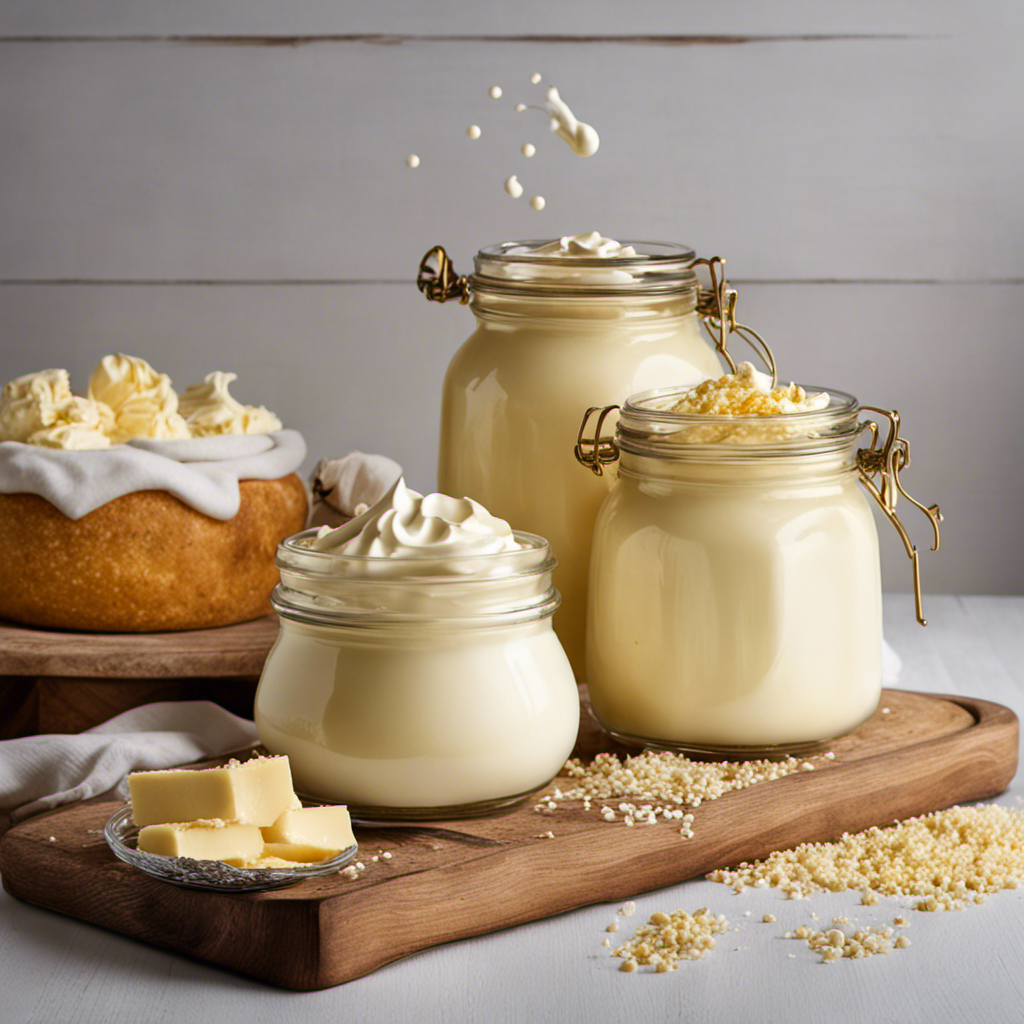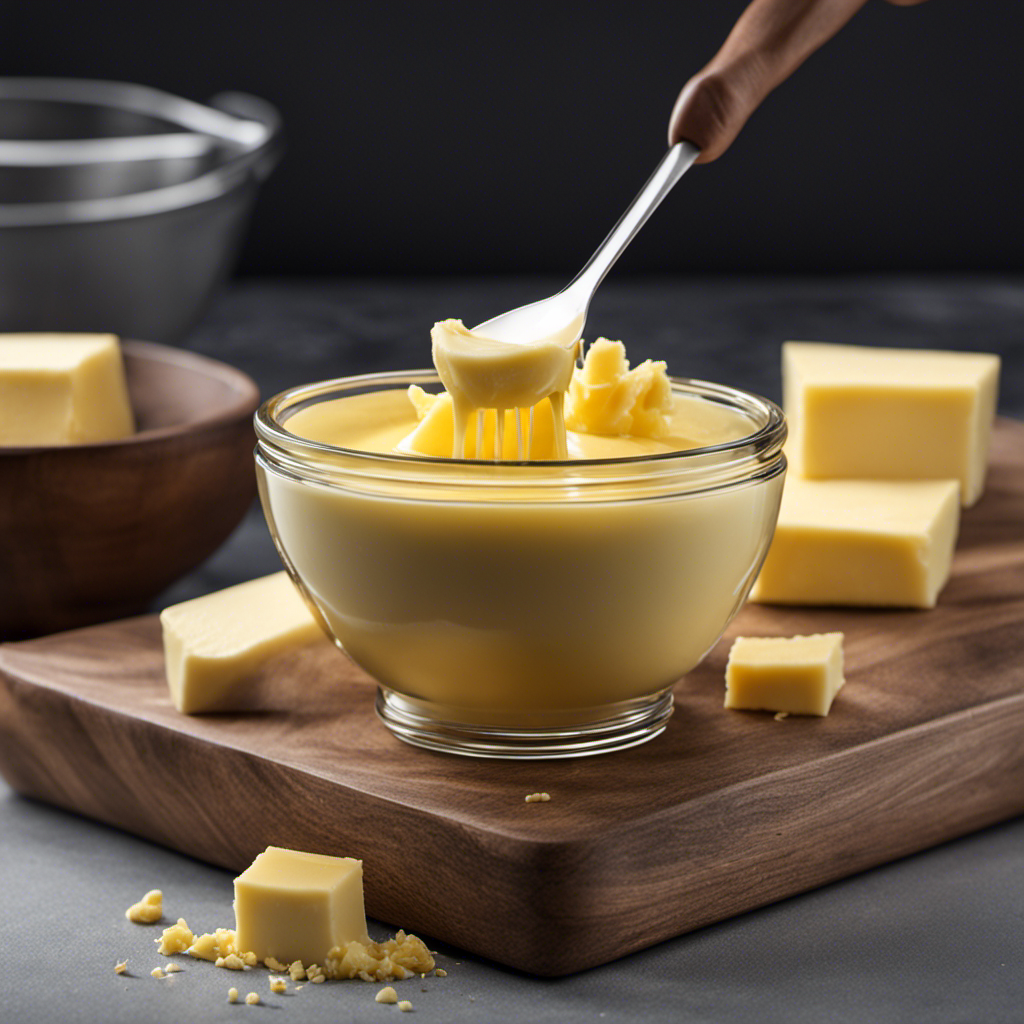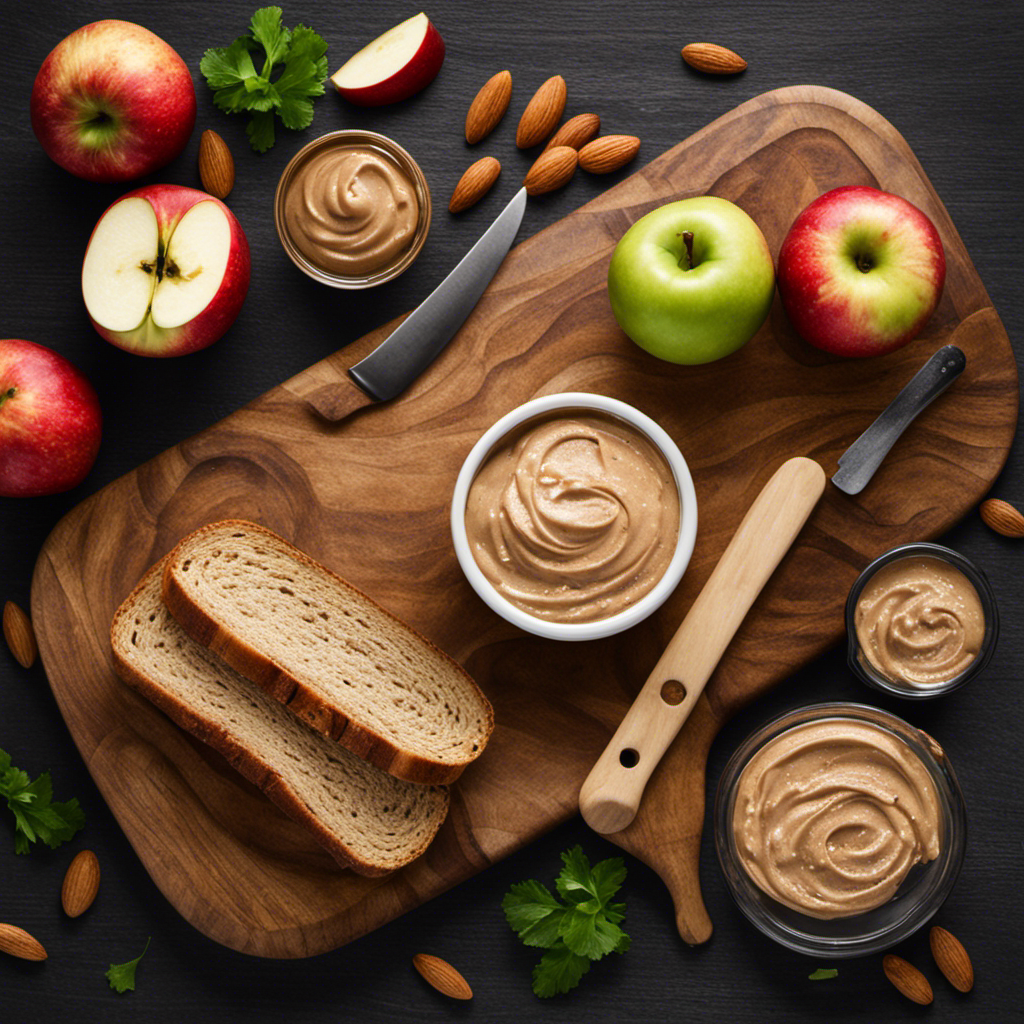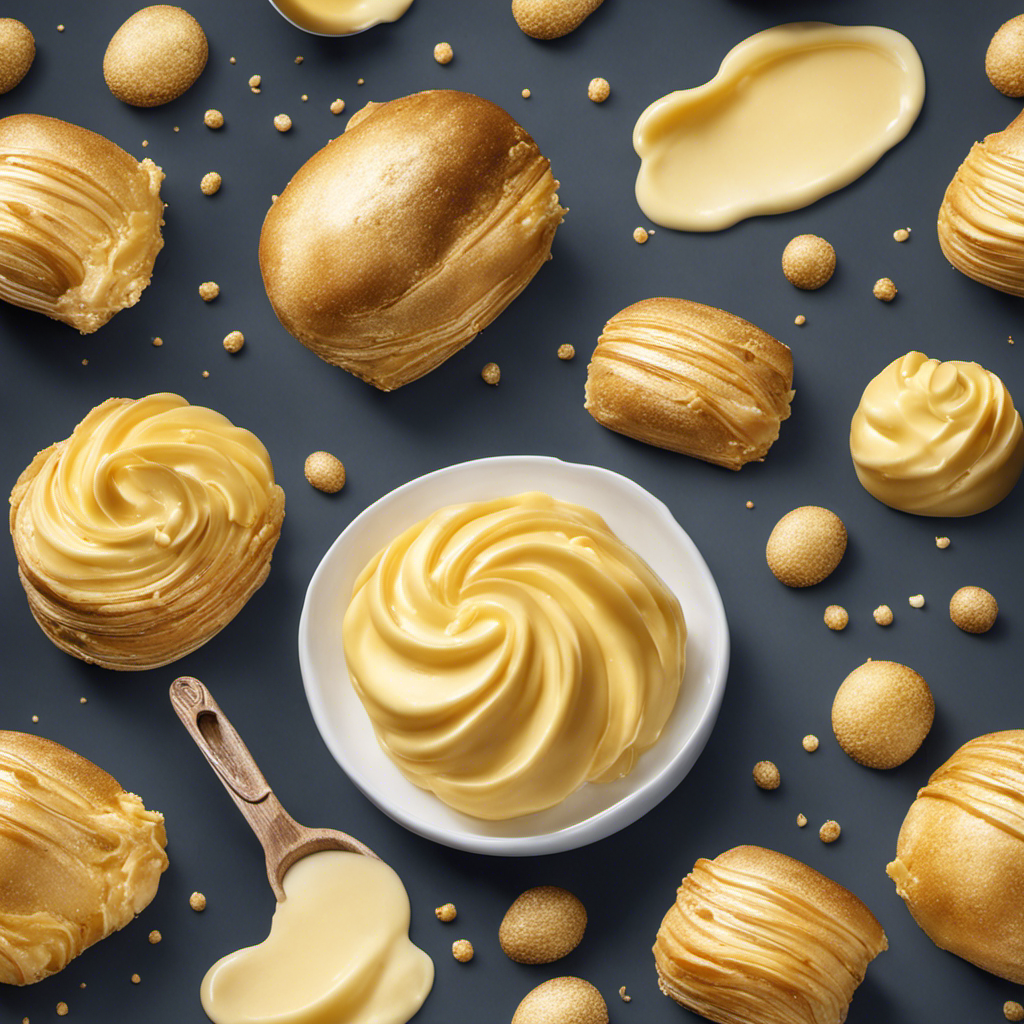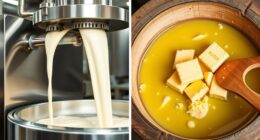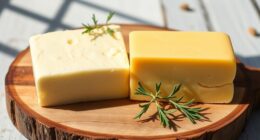Hey! Are you aware that coconut butter is not only tasty but also rich in vital nutrients?
In this article, I’ll guide you through the process of making your own creamy and smooth coconut butter. With just a few simple steps, you’ll be able to enjoy the rich flavor and versatility of this homemade treat.
So, let’s get started and unlock the wonders of coconut butter together!
Key Takeaways
- Select coconuts that are heavy, mold-free, and without cracks.
- Blend the coconut meat for a sufficient amount of time to achieve a smooth and creamy texture.
- Use coconut butter in a variety of sweet and savory dishes for added flavor and health benefits.
- Store coconut butter in a cool, dark place in an airtight container to maintain quality.
Gather the Necessary Ingredients
First, make sure you’ve got all the ingredients you need to make coconut butter. Selecting the right coconuts is crucial for a successful outcome. Look for coconuts that are heavy for their size and have no mold or cracks. Shake them to make sure you can hear the sound of water inside.
Once you have your coconuts, the next step is blending. To achieve a smooth and creamy texture, it is important to blend the coconut meat for a sufficient amount of time. Start with low speed to break down the coconut, and gradually increase to high speed. This will help release the natural oils and create a creamy consistency. It is recommended to pause occasionally, scrape down the sides, and continue blending until you achieve the desired texture.
Now that we have covered the tips for blending, let’s move on to selecting the right type of coconut.
Select the Right Type of Coconut
When it comes to selecting the right type of coconut for your recipe, there are a few key considerations to keep in mind.
One of the first decisions you’ll need to make is whether to use fresh or dried coconut. Fresh coconut offers a distinct flavor and texture, while dried coconut provides convenience and a longer shelf life.
Additionally, you’ll want to think about whether you prefer a sweet or savory coconut flavor, as this will impact the overall taste of your dish.
Fresh or Dried
To make coconut butter, you can use either fresh or dried coconut. Fresh coconut has its own unique benefits when it comes to making coconut butter. Here are some key reasons why fresh coconut is a great option:
- Higher nutrient content: Fresh coconut is packed with essential vitamins, minerals, and antioxidants that can contribute to overall health and well-being.
- Rich in healthy fats: Fresh coconut contains medium-chain triglycerides (MCTs), which are known for their potential health benefits, including supporting heart health and aiding in weight management.
- Natural flavor and aroma: Using fresh coconut can enhance the taste and aroma of your coconut butter, giving it a fresh and tropical twist.
- Creamier texture: Fresh coconut tends to have a higher moisture content, resulting in a smoother and creamier coconut butter.
- Less processing: By using fresh coconut, you can avoid any additional processing or additives that may be present in dried coconut.
Now that we understand the benefits of fresh coconut, let’s explore the next aspect of making coconut butter: the choice between sweet or savory flavors.
Sweet or Savory?
Now that we’ve covered the benefits of fresh coconut, let’s delve into the decision between sweet or savory flavors. When it comes to coconut, there are various ways to enjoy its delicious taste. Some prefer the sweetness of coconut in desserts, while others enjoy the savory flavor it adds to savory dishes. But besides satisfying our taste buds, these flavor choices also have health benefits. Sweet coconut dishes can provide a natural source of energy and essential nutrients like vitamins and minerals. On the other hand, savory coconut dishes can be a great source of healthy fats and can help in reducing inflammation. So, whether you choose sweet or savory, you can enjoy the taste of coconut while reaping its health benefits.
| Sweet Coconut Dishes | Savory Coconut Dishes | Health Benefits |
|---|---|---|
| Coconut Macaroons | Coconut Curry | Natural Source of Energy |
| Coconut Ice Cream | Coconut Rice | Essential Nutrients |
| Coconut Pancakes | Coconut Shrimp | Healthy Fats |
Prepare the Coconut for Butter Making
First, you’ll need to scoop out the coconut meat from the shell. This is a crucial step in preparing the coconut for butter making. Once the coconut meat is extracted, you can move on to the next steps. Here are some tips to help you get started:
- Use a spoon or butter knife to carefully remove the coconut meat from the shell.
- Rinse the coconut meat with water to remove any excess debris.
- Pat the coconut meat dry with a clean towel to remove any excess moisture.
- Cut the coconut meat into small pieces to make it easier to process.
- Place the coconut meat in a food processor or blender and blend until smooth and creamy.
Extracting coconut oil and making coconut butter have numerous health benefits. Coconut oil is rich in medium-chain fatty acids, which are easily digested and can provide a quick source of energy. It also contains lauric acid, which has antimicrobial properties.
Coconut butter, on the other hand, is a great source of dietary fiber, vitamins, and minerals. It can improve digestion, boost the immune system, and support healthy brain function. Incorporating coconut butter into your diet can contribute to overall wellness and vitality.
Extract the Coconut Meat
After carefully removing the coconut meat from the shell, I rinse it with water to ensure there is no residual debris. This step is crucial to maintain the quality and purity of the coconut butter. Once the meat is clean, I proceed to blend it to create a smooth and creamy texture. To achieve the best results, I recommend using a high-powered blender. This will ensure that the coconut meat is thoroughly processed and the butter is silky smooth. Additionally, it is important to store the coconut butter in an airtight container to prevent oxidation and maintain its freshness. It can be stored at room temperature for up to two weeks or refrigerated for longer shelf life. Proper blending and storage techniques are essential in creating and preserving delicious homemade coconut butter.
| Blending Tips | Storage Methods |
|---|---|
| Use a high-powered blender | Store in an airtight container |
| Blend until smooth and creamy | Keep at room temperature for up to two weeks |
| Ensure thorough processing | Refrigerate for longer shelf life |
Blend the Coconut Meat Into a Paste
When it comes to blending techniques for coconut meat paste, there are a few key methods to consider.
One option is to use a high-speed blender to achieve a smooth and creamy consistency.
Another technique is to use a food processor, which can help break down the coconut meat into a paste-like texture.
Additionally, alternative uses for coconut meat paste include incorporating it into smoothies, spreads, or even using it as a base for vegan desserts.
Blending Techniques for Paste
To achieve a smooth consistency, you’ll need to blend the coconut flakes on high speed for several minutes. Blending is a key step in making coconut butter, as it helps break down the flakes and release their natural oils.
Here are some blending tips to help you achieve the right consistency:
-
Use a high-powered blender: A powerful blender will ensure a smooth and creamy texture. Avoid using low-powered blenders, as they may not be able to fully process the coconut flakes.
-
Start with small batches: Blending small batches of coconut flakes at a time will help ensure even blending and prevent the blender from getting overloaded.
-
Scraping the sides: While blending, stop the blender occasionally to scrape down the sides. This will ensure that all the coconut flakes are evenly blended.
-
Add a little oil: If you find that the coconut flakes are not blending smoothly, you can add a small amount of coconut oil to help facilitate the blending process.
-
Be patient: Achieving the right consistency may take some time, so be patient and continue blending until you reach the desired smoothness.
Alternative Uses for Paste
Now that we have learned about different blending techniques for making coconut butter paste, let’s explore some alternative uses for this versatile ingredient.
Coconut butter can be used in a variety of creative recipes, adding a rich and creamy texture to both sweet and savory dishes. One delicious way to use coconut butter is by incorporating it into smoothies or milkshakes for an added boost of flavor and healthy fats.
It can also be used as a spread on toast or as a topping for pancakes or waffles. In baking, coconut butter can be a great substitute for regular butter or oil, adding a hint of tropical flavor to cakes, cookies, and brownies. Additionally, it can be used as a base for homemade granola bars, energy balls, or even as a drizzle on top of ice cream.
The possibilities are truly endless when it comes to experimenting with alternative uses for coconut butter paste.
Optional Step: Toast the Coconut for Added Flavor
If you want to enhance the flavor, you can definitely toast the coconut before making the coconut butter. Toasting the coconut adds a nutty and caramelized taste to the final product. The toasting process involves baking the shredded coconut in the oven until it turns golden brown.
Here are five reasons why toasting the coconut can enhance the flavor of your coconut butter:
- It brings out the natural oils in the coconut, intensifying the flavor.
- It adds a pleasant aroma to the coconut butter.
- Toasting reduces the moisture content in the coconut, resulting in a smoother and creamier texture.
- The Maillard reaction that occurs during toasting creates complex flavors and enhances the overall taste profile.
- Toasted coconut adds a subtle crunch and depth of flavor to the coconut butter.
After toasting the coconut, you can proceed to the next step of making coconut butter, which is adding any desired additional ingredients.
Add Any Desired Additional Ingredients
When it comes to making coconut butter, there are endless possibilities for flavor variations. By adding additional ingredients, you can create a wide range of unique and delicious butters.
From sweet options like vanilla extract and cinnamon to savory combinations like garlic and herbs, the choice is yours. Experimenting with ingredient pairings can elevate the taste and texture of your coconut butter, enhancing its versatility in various dishes.
Additionally, customizing your coconut butter allows you to cater to specific dietary needs or preferences. You can add protein powder for an extra boost or adjust the sweetness level to suit your taste.
Overall, making coconut butter gives you the freedom to get creative and personalize your spreads. So go ahead and explore different flavors and ingredient combinations to discover your favorite variations.
Flavor Variations for Butter
To add some variety to your coconut butter, you can experiment with different flavors. Adding additional ingredients can enhance the taste and create unique flavor pairings. Here are some recipe ideas to inspire you:
- Vanilla: Add a few drops of vanilla extract to give your coconut butter a sweet and aromatic flavor.
- Cinnamon: Sprinkle some ground cinnamon into your coconut butter for a warm and comforting taste.
- Matcha: Mix in a teaspoon of matcha powder to create a vibrant and slightly earthy coconut butter.
- Cocoa: Stir in some cocoa powder for a rich and chocolatey twist.
- Almond: Blend in a handful of toasted almonds to add a nutty and crunchy texture.
These flavor variations will turn your plain coconut butter into a delicious and versatile spread that can be enjoyed in many different ways.
Ingredient Pairing Suggestions
For a unique and flavorful spread, try blending in ingredients like toasted almonds or ground cinnamon. Ingredient substitution is an exciting way to experiment in the kitchen and create new and creative recipe ideas.
When it comes to making coconut butter, there are endless possibilities for ingredient pairings that can take your spread to the next level.
One delicious substitution option is to replace the almonds with other nuts like cashews or walnuts. These nuts add their distinct flavors and textures to the butter, creating a nutty and rich taste. Additionally, you can try incorporating spices like cardamom or nutmeg for a warm and aromatic twist. These spices not only enhance the flavor of the coconut butter but also provide health benefits.
Customizing Your Coconut Butter
Now that we’ve explored some delicious ingredient pairings for coconut butter, let’s take a moment to discuss how you can customize your own coconut butter to suit your taste preferences and creative applications.
Flavor combinations:
- Chocolate and coconut: Add cocoa powder or melted dark chocolate for a rich and indulgent twist.
- Matcha and coconut: Mix in matcha powder for a vibrant green color and earthy flavor.
- Spices and coconut: Experiment with cinnamon, nutmeg, or cardamom to add warmth and complexity.
- Citrus and coconut: Zest some lemon or orange peel into your coconut butter for a refreshing citrus kick.
- Savory and coconut: Try adding a pinch of sea salt or some herbs like rosemary or thyme for a unique savory twist.
Creative applications:
- Spread it on toast or crackers.
- Use it as a frosting for baked goods.
- Blend it into smoothies for added creaminess.
- Drizzle it over popcorn or roasted vegetables.
- Incorporate it into homemade energy bars or granola.
Process the Coconut Paste Until Smooth and Creamy
Blend the coconut paste until it’s smooth and creamy. To achieve the perfect consistency for your homemade coconut butter, using a high-quality blender is essential. Here are some blender recommendations that will help you create velvety-smooth coconut butter:
| Blender Model | Power | Price |
|---|---|---|
| Vitamix | 2.2 HP | $400 |
| Blendtec | 3 HP | $350 |
| NutriBullet | 600 W | $80 |
| Ninja | 1000 W | $100 |
| KitchenAid | 3.5 HP | $500 |
Now, let’s dive into the health benefits of coconut butter. Coconut butter is not only delicious but also packed with nutrients. It is rich in healthy fats, including medium-chain triglycerides (MCTs), which can boost brain function and aid in weight management. Additionally, coconut butter contains lauric acid, a fatty acid known for its antimicrobial and antiviral properties. It also provides essential vitamins and minerals like vitamin E and iron. Incorporating coconut butter into your diet can have numerous positive effects on your overall health and well-being.
Store the Coconut Butter Properly
To maintain the freshness and consistency of your homemade coconut butter, it’s important to store it properly. Improper storage can lead to spoilage and a shorter shelf life. Here are some key tips for storing coconut butter effectively:
-
Keep it in an airtight container: Airtight containers prevent exposure to air and moisture, which can cause the coconut butter to spoil.
-
Store it in a cool, dark place: Heat and light can degrade the quality of the coconut butter, so it’s best to keep it in a cool and dark pantry or cupboard.
-
Avoid direct sunlight: Sunlight can cause the coconut butter to melt and spoil faster, so it’s important to keep it away from direct sunlight.
-
Stir it occasionally: Over time, the oil in coconut butter may separate from the solids. Stirring it occasionally helps to maintain a consistent texture.
-
Check for any signs of spoilage: Before using the coconut butter, always check for any signs of mold, off smells, or unusual texture. If any of these are present, it’s best to discard the coconut butter to avoid any health risks.
Ways to Use Coconut Butter in Recipes
When storing your homemade coconut butter, it’s important to keep it in an airtight container to prevent spoilage.
But once you have your coconut butter ready, there are many delicious ways to incorporate it into your daily routine.
One simple way is to spread it on toast or crackers for a creamy and nutritious snack.
You can also use it as a topping for pancakes or waffles, adding a rich coconut flavor to your breakfast.
Coconut butter can be a great addition to smoothies, giving them a creamy texture and a boost of healthy fats.
Moreover, it can be used as a substitute for traditional butter or oil in baking recipes, providing a unique tropical taste.
The health benefits of using coconut butter in recipes include its high content of medium-chain triglycerides, which can promote weight loss and improve brain function.
Additionally, coconut butter is rich in healthy saturated fats, which can increase HDL cholesterol levels and support heart health.
Troubleshooting Common Issues While Making Coconut Butter
If your homemade coconut butter turns out grainy instead of smooth, try adding a little bit of melted coconut oil and blending it again. Texture problems can arise while making coconut butter, but there are solutions to troubleshoot these issues. Here are some tips to help you achieve a creamy and smooth coconut butter:
- Ensure that the coconut flakes or shredded coconut you are using are fresh and of good quality.
- Use a high-speed blender or food processor to thoroughly blend the coconut flakes until they release their oils and become creamy.
- If the coconut butter is too dry and crumbly, add a small amount of melted coconut oil to improve the texture.
- Blend the coconut butter for a longer duration to achieve a smoother consistency.
- Allow the coconut butter to cool completely before storing it in an airtight container.
Frequently Asked Questions
Can I Use Any Type of Coconut to Make Coconut Butter?
Yes, you can use different types of coconuts to make coconut butter. The taste and texture of homemade coconut butter may vary depending on the type of coconut used. Homemade coconut butter has several benefits, such as being rich in healthy fats and antioxidants.
Is It Necessary to Toast the Coconut Before Blending It Into a Paste?
Toasting coconut before blending it into a paste has several benefits. It enhances the flavor, adds a nutty aroma, and improves the texture. However, there are alternative methods for making coconut butter without toasting, such as using raw coconut flakes.
What Additional Ingredients Can I Add to Enhance the Flavor of Coconut Butter?
To enhance the flavor of coconut butter, I recommend adding a dash of cinnamon, a drizzle of honey, or a sprinkle of sea salt. These simple additions can take your coconut butter to the next level of deliciousness.
How Long Does It Take to Process the Coconut Paste Until It Becomes Smooth and Creamy?
When processing coconut paste, it typically takes about 10-15 minutes to achieve a smooth and creamy texture. Different methods, such as using a blender or food processor, can be used to make coconut butter.
How Should I Store the Coconut Butter to Ensure Its Freshness and Longevity?
To ensure freshness and longevity of coconut butter, store it in an airtight container in a cool, dry place. Avoid exposure to heat and sunlight, as they can accelerate spoilage. Properly stored, coconut butter can have a shelf life of several months.
Conclusion
In conclusion, making coconut butter is a straightforward and rewarding process. By carefully selecting the right type of coconut and following the necessary steps, you can create a smooth and creamy butter that can be used in a variety of recipes.
Remember to store the coconut butter properly to ensure its freshness and flavor. With a little patience and attention to detail, you can enjoy the rich and delectable taste of homemade coconut butter.
So, don’t let the coconut butter-making process be a hard nut to crack, give it a try and savor the fruits of your labor.

